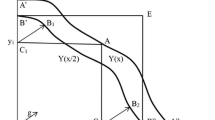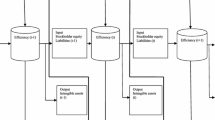Abstract
Diversification is often seen as a risk management tool, but specialization allows operators to exploit scale economies in single outputs and offers specialized operators more opportunities to fine-tune their skills which can promote a greater degree of technical proficiency. Measuring economies of scope facilitates the assessment of the benefits from output diversification versus specialization for operators and provides a metric for explaining and predicting trends towards specialization or diversification. However, the current literature on economies of scope provides little insight into the potential trade-off between the benefits of diversification and the presence of inefficiency in production and decision making. To remedy this shortcoming, this paper develops a measure of an effective (or behavioral) measure of scope economies which measures the benefits of diversification accounting for the contributions of allocative, congestion and technical efficiency in scaling the perfectly efficient version of scope economies. The application focuses on measuring and explaining economies of scope on Dutch crop farms.
Similar content being viewed by others
Notes
Coeymans and Mundlak (1992) differentiate between the range of actual and implemented technologies that are endogenous choices based on economic forces (e.g., relative factor prices). In this sense the technology used is based on prices and if allocative inefficiency is present, the shadow prices can influence the choice of implementable technology. In the context of efficiency analysis, an absolute efficiency measures is typical elusive and the best we can characterize a firm’s efficiency level is in the relative sense. But taking a step further back, the question of the production function as a real entity is questionable. In the context of economic analyses, economist starting back as far as Marshall have proposed the specification of a functional relationship that transforms inputs into outputs. When dealing with production scientists, often times the production process is modeled as discrete sequence of product development stages in the sense of a difference equation system. The final form solution of this difference equation system can be viewed as the production function.
The measurement of BES, as opposed to PES, permits the analysis of the BES individual components, i.e. to assess to what extent the decomposition measures impact the economies of scope.
The model (8) is infeasible for a subgroup of the efficient firms, i.e. the subgroup of firms for which each marginal increment of output is outside the production possibility set.
The deflators for capital in structures and machinery and installations are calculated from the data supplied by the LEI accounting system. Comparison of the balance value in year t and the balance value in year t-1 gives the yearly price correction used by the LEI. This price correction is used to construct a price index for capital and a price index for buildings, machinery and installations. These price indices are used as deflators.
Given that we analyse farms in the small country of the Netherlands, the assumption of the same input prices is reasonable because farms in the sample have the access to the same markets for inputs and outputs.
In this way, we assume a homogenous technology for all farms in the sample, which seems to be a proper assumption for analyzed farms because: (1) all farms are located in the Netherlands which is a small country with very small differences between regions, (2) all farms face similar weather conditions. In addition, assuming a heterogeneous technology for, for example, the rootcrops and cereal farms and conducting the estimations separately for these types of farms, we would end up with too small sample size to obtain a reliable results given a relatively large number of dimensions (i.e. the number of inputs and outputs).
Bootstrapping of DEA efficiency was so far developed in the literature for technical efficiency scores only. Therefore, our analyses of bootstrap confidence intervals are limited to this kind of efficiency.
Chavas and Aliber (1993) generate both short run and long run efficiency estimates for nine different Wisconsin dairy production districts. For comparison in this study, the weighted group means are calculated from their Table 2, p. 10, the short run measures for TE and AE are 0.93 and 0.83, respectively. The weighted mean for the measure of scope economies from the same table is 1.50; albeit this is a long run measure (no short run measure is reported).
The Komolgorov–Smirnoff test does not reject normal distributions of PES with a test statistic of 0.124 and 0.082 for small and large farms, respectively, both significant at < 0.001. Small farms have a sample mean of 1.14 and standard deviation of 0.198, while large farms have a sample mean of 1.09 and standard deviation of 0.152.
Dummy variables reflecting soil type and characteristics related to the farm operator (education, presence of a successor, and tenure status) did not contribute significantly to the explanatory power of the regression.
A discrete approximation of the marginal impact can be achieved by:\( \frac{{C_{z}^{*} (y^{i} ,w,z) + C_{z}^{*} (y^{T - i} ,w,z) - C_{z}^{*} (y,w,z)}}{{C_{z}^{*} (y,w,z)^{2} }} \), where \( C_{z}^{*} (y,w,z) \), \( C_{z}^{*} (y^{i} ,w,z) \) and \( C_{z}^{*} (y^{N - i} ,w,z) \) are the dual values associated with the constraint on the z-inputs in the cost minimization problems in (5), (2) and (3), respectively.
References
Agricultural Economics Research Institute and Central Bureau of Statistics (LEI/CBS), various years. Landbouwcijfers, The Hague
Ahn T, Seiford LM (1993) Sensitivity of DEA to models and variable sets in an hypothesis test setting: the efficiency of university operations. In: Ijiri Y (ed) Creative and innovative approaches to the science of management. Quorum Books, New York
Baumol WJ, Panzar JC, Willig RD (1982) Contestable markets and the theory of industry structure. Harcourt Brace Jovanovich, New York
Carlson S (1965) A study of the pure theory of production. Reprint of Economic Classics. August M. Kelley
CBS (2012) Daling arbeidsvolume landbouw, aandeel gezinsarbeid verder afgenomen. http://www.cbs.nl/nl-L/menu/themas/landbouw/publicaties/artikelen/archief/2012/2012-arbeid-2012-art.htm. Accessed on 25 May 2014
Chambers RG, Färe R (2008) A “calculus” for data envelopment analysis. J Prod Anal 30:169–175
Chambers RG, Just RE (1989) Estimating multioutput technologies. Am J Agric Econ 71(4):81–995
Charnes A, Neralic L (1992) Sensitivity analysis of the proportionate change of inputs (or outputs) in data envelopment analysis. Glasnik Matematicki 27:393–405
Chavas JP, Aliber M (1993) An analysis of economic efficiency in agriculture: a nonparametric approach. J Agric Resour Econ 18(1):1–16
Coeymans JE, Mundlak Y (1992) Endogenous technology and sectoral productivity: Chile 1962–82. J Prod Anal 3(3):257–275
Coffey BK, Featherstone AM (2004) Nonparametric estimation of multiproduct and product-specific economies of scale. Selected paper presented at the annual meetings of the Southern Agricultural Economics Association, Tulsa, OK
Cooper WW, Seiford LM, Tone K (1999) Data envelopment analysis: a comprehensive text with models, applications, references and DEA-solver software. Kluwer Academic, Norwell
Cooper WW, Li S, Seiford LM, Tone K, Thrall LM, Zhu J (2001) Sensitivity and stability analysis in DEA: some recent developments. J Prod Anal 15:217–246
Cooper WW, Li S, Seiford LM, Zhu J (2011) Sensitivity analysis in DEA. In: Cooper WW, Seiford LM, Zhu J (eds) Handbook on data envelopment analysis, Chapt 3. Springer, New York, pp 71–91
Cox TL, Wohlgenant MK (1986) Prices and quality effects in cross-sectional demand analysis. Am J Agric Econ 68(4):908–919
Färe R (1986) Addition and efficiency. Q J Econ 101(4):861–866
Färe R, Grosskopf S, Lovell CAK (1994) Production frontiers. Cambridge University Press, New York
Fernandez-Cornejo J, Gempesaw CM II, Elterich JG, Stefanou SE (1992) Dynamic measures of scope and scale economies: an application to German agriculture. Am J Agric Econ 74(3):329–342
Frisch R (1965) Theory of production. Rand McNally and Company, Chicago
Goodwin BK, Featherstone AM, Zeuli K (2002) Producer experience, learning by doing, and yield performance. Am J Agric Econ 84(3):660–678
Hall RE (1973) The specification of technology with several kinds of output. J Polit Econ 81(4):878–892
Hasenkamp G (1976) Specification and estimation of multiple output production functions. Lecture Notes in Economics and Mathematical Systems, no. 120. Springer, Berlin
Just RE, Zilberman D, Hochman E (1983) Estimation of multicrop production functions. Am J Agric Econ 65(4):770–780
Kohli U (1983) Non-joint technologies. Rev Econ Stud 50(1):209–219
Kuosmanen T, Kortelainen M (2012) Stochastic non-smooth envelopment of data: semi-parametric frontier estimation subject to shape constraints. J Prod Anal 38(1):11–28
Lau LJ (1972) Profit functions of technologies with multiple inputs and outputs. Rev Econ Stat 54(3):281–289
Mittelhammer RC, Matulich SC, Bushaw D (1981) On implicit forms of multiproduct-multifactor production functions. Am J Agric Econ 63(1):l64–l68
Mundlak Y (1964) Transcendental multi-product production functions. Int Econ Rev 5(3):273–284
Olesen OB (1995) Some unsolved problems in data envelopment analysis: a survey. Int J Prod Econ 39(1–2):5–36
Panzar JC, Willig RD (1977) Economies of scale in multi-output production. Quart J Econ 91(3):481–493
Samuelson PA (1966) The fundamental singularity theorem for non-joint production. Int Econ Rev 7(1):34–41
Shumway CR (1983) Supply, demand and technology in a multiproduct industry, Texas field crops. Am J Agric Econ 65(4):748–760
Shumway CR, Pope RD, Nash EK (1984) Allocatable fixed inputs and jointness in production, implications for economic modeling. Am J Agric Econ 66(1):72–78
Simar L, Wilson PW (1998) Sensitivity analysis of efficiency scores: how to bootstrap in nonparametric frontier models. Manag Sci 44(1):49–61
Simar L, Wilson PW (2011) Inference by the m out of n bootstrap in nonparametric frontier models. J Prod Anal 36(1):33–53
Thompson RG, Dharmapala PS, Diaz J, Gonzalez-Lima MD, Thrall RM (1996) DEA multiplier analytic center sensitivity analysis with an illustrative application to independent oil cos. Ann Oper Res 66:163–180
Thrall RM (1989) Classification of transitions under expansion of inputs and outputs. Manag Decis Econ 10:159–162
Wilson PW (1995) Detecting influential observations in data envelopment analysis. J Prod Anal 6:27–46
Author information
Authors and Affiliations
Corresponding author
Appendix
Appendix
Färe et al. (1994), assuming constant returns to scale, develop the decomposition of input economic efficiency measure (EE) into input allocative efficiency (AE) and input technical efficiency that assumes strong disposability of inputs under constant returns to scale (TEC):
Input technical efficiency component assuming strong disposability of inputs relative to constant returns to scale (TEC) is further decomposed into a measure of input scale efficiency (SE), input congestion (C) and input pure technical efficiency assuming weak disposability of inputs relative to variable returns to scale (TEV). Therefore, the final decomposition developed by Färe et al. (1994) can be summarized as below:
Hence, in this decomposition input economic inefficiency may be due to selection of the wrong input mixed as measured by allocative efficiency, adaptation of inefficient scale, input congestion or pure technical inefficiency.
In the paper we adapt this decomposition imposing variable returns to scale, because this assumption allows for the analysis of economies of scope. This assumption causes that in our decomposition we do not distinguish scale efficiency component. Therefore, the final decomposition on which the paper relies upon decomposes input economic efficiency into input allocative efficiency, congestion and input pure technical efficiency assuming weak disposability of inputs relative to variable returns to scale:
Rights and permissions
About this article
Cite this article
Oude Lansink, A., Stefanou, S.E. & Kapelko, M. The impact of inefficiency on diversification. J Prod Anal 44, 189–198 (2015). https://doi.org/10.1007/s11123-014-0423-x
Published:
Issue Date:
DOI: https://doi.org/10.1007/s11123-014-0423-x




